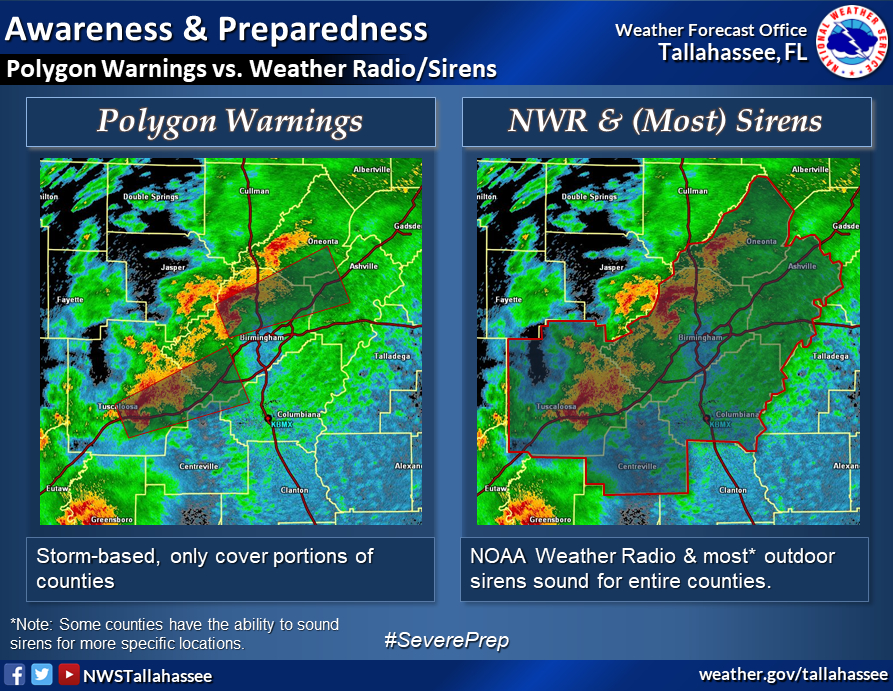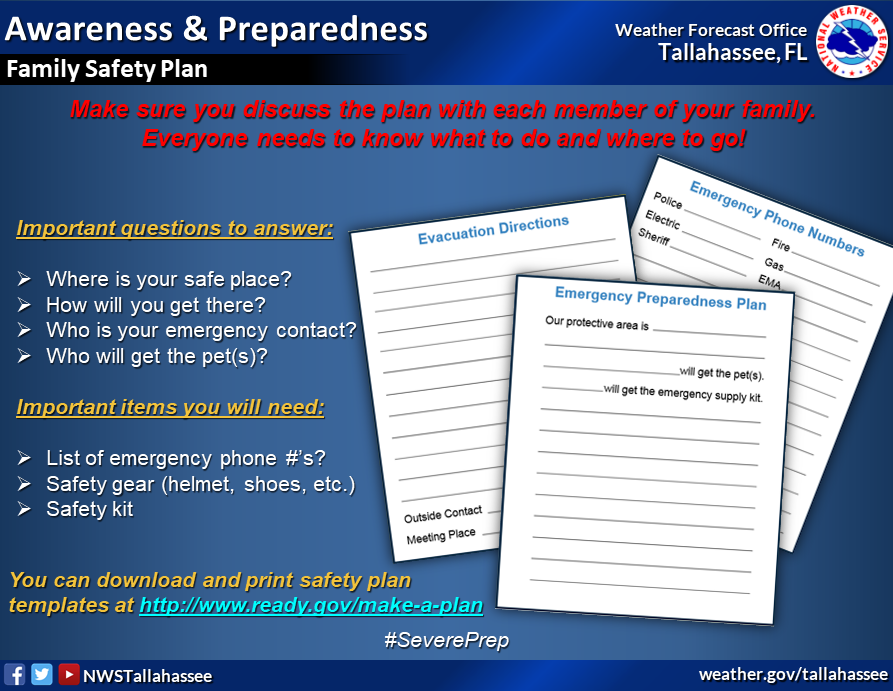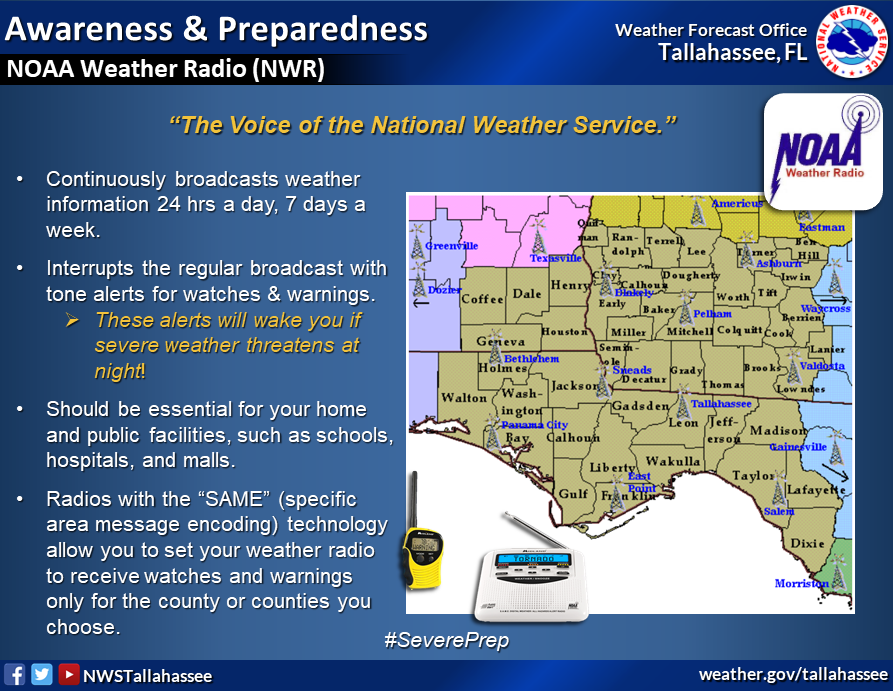Severe Weather Awareness

| Introduction | Weather Hazards | Sales Tax Holiday | Important Information |
| Tornado Safety Drill | Additional Info |
While severe weather can occur across the southern portions of the US at all times of the year, we typically have two or three distinct periods of severe weather across our portion of the country. These are typically in the early spring months of March and April, the summer rainy season from June through late August, and one last peak from November into January. The nature of our severe weather varies with the season. In the wintertime and spring months, stronger cold fronts occasionally move through and provide the wind shear necessary for severe weather in the form of tornadoes and damaging wind gusts. During the summer months, the severe weather events are mostly comprised of damaging winds from downbursts in afternoon storms called microbursts. While uncommon, tornadoes still are possible in summer across our region, but they normally come from either tropical systems, or waterspouts along the coast. Very rarely will we have a dynamic system in the summer that provides all the ingredients for tornadoes. Additionally, while lightning is not a criteria for severe weather warnings, it still needs to be considered when planning your outdoor activities! While the severity of each severe weather season varies from year to year, it's imperative that you stay prepared year-round as all modes of severe weather are worth preparing for!
The National Weather Service, and our emergency management partners in Alabama, Georgia, Florida, and other critical partners ask for your help in providing the public with information about severe weather safety. Advance planning and increased awareness will help residents of our states tackle the challenges of severe weather.
|
There are many aspects to being prepared for severe weather, but first and foremost, KNOW WHERE YOU LIVE!! No matter what you have in your severe weather plan, it will never be complete until you can pinpoint your location on a map. Take a few moments NOW to learn some local geography so you can be more prepared when severe weather strikes. Don't just stop at your home location, learn surrounding counties and communities. This extra bit of knowledge will help you determine if storms in other areas are heading your way. Knowledge is power, a power that could SAVE YOUR LIFE!! Want to know which office serves your city? Even if you don't use social media, visit weather.gov/socialmedia and type in the city or zip code where you reside.
|
 |
 |
 |
 |
Severe weather comes in many forms across the tri-state region. From tornadoes to flooding, we see it all. It's important to know the different weather hazards and some simple safety tips. Please review the graphics below to learn how to prepare and keep you and your family safe from each type of hazard. (Click on images for a larger view.)
|
Weather Hazards & Safety Tips |
 Severe Thunderstorms |
 Tornado Safety |
 Flooding Safety |
 Flood Types |
 Receiving Alerts |
 Lightning Statistics |
 Lightning Safety |
 Lightning Safety |
 Wireless Alerts |
 NOAA Weather Radio |
Resiliency & Manufactured Homes
|
Resiliency is defined as the capacity to recover quickly from difficulties. Across the tri-state region, especially in Alabama, we find ourselves at the unique intersection of risk and vulnerability that makes us more susceptible to the major effects from high impact weather events. Severe weather is inevitable, but much of the southeast also has a large manufactured home population. The more dispersed nature of these manufactured homes makes them 4 times more likely to be struck by a tornado than those in Kansas! The ultimate goal is to make Alabama, and the rest of the tri-state region, more resilient when it comes to severe weather. So, how do we do this? Well, the answer isn't simple, and it will take some time, but together we can do it. The following graphics include data and illustrations based on research conducted by Dr. David Roueche (University of Auburn) on Structural Successes and Failures for Mobile Homes in Alabama, and also by Stephen Strader (Villanova University) and Walker Ashley (Northern Illinois University) on Mobile Home Tornado Vulnerability in Alabama. |
"Tornado Safety Drill" - Wednesday, February 5, 2025
Alabama and Florida will conduct a test tornado drill at 10am ET and 9am CT while Georgia will conduct theirs at 9:30 am ET. This "tornado safety drill" will be done instead of our routine weekly NOAA All-Hazards Radio Test. An actual tornado warning WILL NOT sound, but this is an excellent opportunity for schools, civic organizations and businesses around Central Alabama to practice what they would do in the event of a tornado warning.
**Please note that some NOAA Weather Radio models do not have an audible sound for the Routine Weekly Test (they only show a flashing light). If you are conducting a drill, please go ahead and conduct the drill even if your weather radio does not audibly alert.**
Sales Tax Holiday (Alabama Only): February 21-23, 2024
During the last weekend in February, the state of Alabama will hold a sales tax holiday for severe weather preparedness items. Don't miss this great opportunity to purchase any items you may be missing from your emergency kit. Below is a list of tax exempt items. You can find out if your city/town is participating here. Sales tax holiday ends just after 11:59pm CT Sunday February 23.
Florida also has a sales tax weekend that covers many disaster preparedness items. We don't have information on when the next one will be but Florida has a history of doing these sales tax holidays close to the beginning of Hurricane Season. Please visit the Florida Department of Revenue to check on the dates of potential tax holidays.